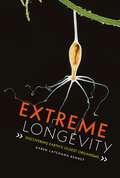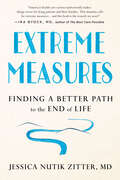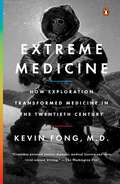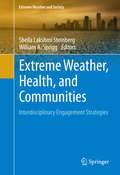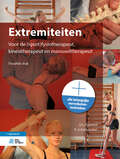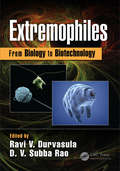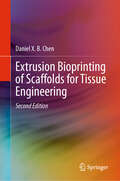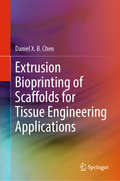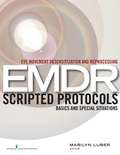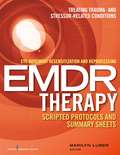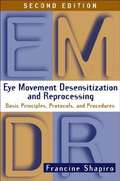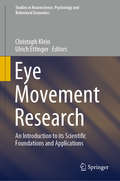- Table View
- List View
Extreme IR: Extraordinary Cases in Interventional Radiology and Endovascular Therapies
by Ziv J HaskalThis book presents 101 unique and extraordinary cases in interventional radiology (IR) and endovascular therapy. Extreme IR is an internationally recognized event that Dr. Ziv Haskal created and held in early 2000's at mountaintop venues, then at successive Society of Interventional Radiology annual conference meetings, and later, published monthly within the Journal of Vascular and Interventional Radiology (JVIR) for which he was editor-in-chief for 10 years. The ever-popular Extreme IR sessions at conferences have drawn more than 5,000 attendees. Cases are presented in a rapid-fire format designed to maximize relevancy, excitement, and unique knowledge. This book aims to replicate that experience for a wider audience. The book is divided into twelve sections, including venous, portal hypertension, and biliary, arterial, oncology, etc. cases. Most cases span two pages and include large, illustrative images with bullet-pointed text to present essential information in a concise and focused fashion. The global list of authors exemplifies the extraordinary breadth of the cases for interventional radiologists, endovascular specialists. It is ideal for interventional radiologists and endovascular specialists at all levels of seniority and training.
Extreme Longevity: Discovering Earth's Oldest Organisms
by Karen Latchana KenneyMeet the science experts who study specimens of extreme longevity in both the plant and animal kingdoms, such as the 80,000-year-old root system of Pando (a colony of male quaking aspens), 11,000-year-old deep-sea sponges, and 400-year-old sharks. Learn about technologies used to determine age and longevity, including DNA sampling, growth rings, and radiocarbon dating. See how scientists located these long-lived species were and why and how they resist disease and aging. And delve into how scientists are using what they know about aged plants and animals to research how we can promote longevity in humans.
Extreme Measures: Finding a Better Path to the End of Life
by Jessica Nutik ZitterAn ICU and Palliative Care specialist featured in the Oscar-nominated Netflix documentary Extremis offers a framework for a better way to exit life that will change our medical culture at the deepest levelIn medical school, no one teaches you how to let a patient die. Jessica Zitter became a doctor because she wanted to be a hero. She elected to specialize in critical care—to become an ICU physician—and imagined herself swooping in to rescue patients from the brink of death. But then during her first code she found herself cracking the ribs of a patient so old and frail it was unimaginable he would ever come back to life. She began to question her choice. Extreme Measures charts Zitter’s journey from wanting to be one kind of hero to becoming another—a doctor who prioritizes the patient’s values and preferences in an environment where the default choice is the extreme use of technology. In our current medical culture, the old and the ill are put on what she terms the End-of-Life Conveyor belt. They are intubated, catheterized, and even shelved away in care facilities to suffer their final days alone, confused, and often in pain. In her work Zitter has learned what patients fear more than death itself: the prospect of dying badly. She builds bridges between patients and caregivers, formulates plans to allay patients’ pain and anxiety, and enlists the support of loved ones so that life can end well, even beautifully. Filled with rich patient stories that make a compelling medical narrative, Extreme Measures enlarges the national conversation as it thoughtfully and compassionately examines an experience that defines being human.
Extreme Medicine
by Kevin FongAnesthesiologist, intensive care expert, and NASA adviser Kevin Fong explores how physical extremes push human limits and spawn incredible medical breakthroughs.
Extreme Medicine: How Exploration Transformed Medicine in the Twentieth Century
by Kevin FongAnesthesiologist, intensive care expert, and NASA adviser Kevin Fong explores how physical extremes push human limits and spawn incredible medical breakthroughsLittle more than one hundred years ago, maps of the world still boasted white space: places where no human had ever trod. Within a few short decades the most hostile of the world’s environments had all been conquered. Likewise, in the twentieth century, medicine transformed human life. Doctors took what was routinely fatal and made it survivable. As modernity brought us ever more into different kinds of extremis, doctors pushed the bounds of medical advances and human endurance. Extreme exploration challenged the body in ways that only the vanguard of science could answer. Doctors, scientists, and explorers all share a defining trait: they push on in the face of grim odds. Because of their extreme exploration we not only understand our physiology better; we have also made enormous strides in the science of healing.Drawing on his own experience as an anesthesiologist, intensive care expert, and NASA adviser, Dr. Kevin Fong examines how cuttingedge medicine pushes the envelope of human survival by studying the human body’s response when tested by physical extremes. Extreme Medicine explores different limits of endurance and the lens each offers on one of the systems of the body. The challenges of Arctic exploration created opportunities for breakthroughs in open heart surgery; battlefield doctors pioneered techniques for skin grafts, heart surgery, and trauma care; underwater and outer space exploration have revolutionized our understanding of breathing, gravity, and much more. Avant-garde medicine is fundamentally changing our ideas about the nature of life and death.Through astonishing accounts of extraordinary events and pioneering medicine, Fong illustrates the sheer audacity of medical practice at extreme limits, where human life is balanced on a knife’s edge. Extreme Medicine is a gripping debut about the science of healing, but also about exploration in its broadest sense—and about how, by probing the very limits of our biology, we may ultimately return with a better appreciation of how our bodies work, of what life is, and what it means to be human.
Extreme Sports Medicine
by Francesco FelettiThis technically oriented book on medicine as applied to extreme sports offers broad coverage of the field extending well beyond the usual focus on major trauma and acute injuries. In addition to the injuries and diseases associated with individual extreme sports, this book also addresses the topics of psychology, dermatology, ophthalmology, infectious diseases, physiology, nutrition, training, injury prevention strategies, rehabilitation, doping, treatment in hostile environments, and legal aspects. Innovative and less frequently considered topics are also discussed, such as recent advances in protective equipment and materials, the effects of exposure on whole-body vibration, and cold exposure risk management. More than 60 of the most authoritative experts from across the world have contributed to this book, drawing on their personal experiences and including practical examples whenever relevant. Both subject matter and illustrations have been selected with the utmost care, the latter including photographs of world-class athletes. The book's multidisciplinary approach to the subject ensures that it will be relevant to a wide readership.
Extreme Tissue Engineering
by Robert A. BrownHighly Commended at the BMA Book Awards 2013Extreme Tissue Engineering is an engaging introduction to Tissue Engineering and Regenerative Medicine (TERM), allowing the reader to understand, discern and place into context the mass of scientific, multi-disciplinary data currently flooding the field. It is designed to provide interdisciplinary, ground-up explanations in a digestible, entertaining way, creating a text which is relevant to all students of TERM regardless of their route into the field.Organised into three main sections: chapters 1 to 3 introduce and explain the general problems; chapters 4 to 6 identify and refine how the main factors interact to create the problems and opportunities we know all too well; chapters 7 to 9 argue us through the ways we can use leading-edge (extreme) concepts to build our advanced solutions.Students and researchers in areas such as stem cell and developmental biology, tissue repair, implantology and surgical sciences, biomaterials sciences and nanobiomedicine, bioengineering, bio-processing and monitoring technologies - from undergraduate and masters to doctoral and post-doctoral research levels - will find Extreme Tissue Engineering a stimulating and inspiring text.Written in a fluid, entertaining style, Extreme Tissue Engineering is introductory yet challenging, richly illustrated and truly interdisciplinary.
Extreme Weather Events and Human Health: International Case Studies
by Rais AkhtarThis edited book assesses the impacts of various extreme weather events on human health and development from a global perspective, and includes several case studies in various geographical regions around the globe. Covering all continents, it describes the impact of extreme weather conditions such as flash floods, heatwaves, cold waves, droughts, forest fires, strong winds and storms in both developing and developed countries. The contributing authors also investigate the spread of diseases and the risk to food security caused by drought and flooding. Further, the book discusses the economic damage resulting from natural disasters including hurricanes. It has been estimated that in 2017 natural disasters and climate change resulted in economic losses of 309 billion US dollars. Scientists also predict that if nothing is done to curb the effects of climate change, in Europe the death toll due to weather disasters could rise 50-fold by the end of the 21st century, with extreme heat alone causing more than 150,000 deaths a year, as the report on global warming of 1.5°C warns that China, Russia and Canada’s current climate policies would steer the world above a catastrophic 5°C of warming by the end of 2100. As such, the book highlights how the wellbeing of different populations is threatened by extreme events now and in the foreseeable future.
Extreme Weather, Health, and Communities
by Sheila Lakshmi Steinberg William A. SpriggThis volume presents a unique interdisciplinary approach, drawing on expertise in both the natural and social sciences. A primary goal is to present a scientific and socially integrated perspective on place-based community engagement, extreme weather, and health. Each year extreme weather is leading to natural disasters around the world and exerting huge social and health costs. The International Monetary Fund (2012) estimates that since 2010, 700 worldwide natural disasters have affected more than 450 million people around the globe. The best coping strategy for extreme weather and environmental change is a strong offense. Communities armed with a spatial understanding of their resources, risks, strengths, weaknesses, community capabilities, and social networks will have the best chance of reducing losses and achieving a better outcome when extreme weather and disaster strikes.
Extreme and Rare Sports: Performance Demands Drivers Functional Foods And Nutrition
by Debasis Bagchi Sourya DattaTwo crucial components of a healthy life are nutrition and exercise. The importance of appropriate diet, food and nutrition are extremely important to be successful in sports, and, especially, in extreme sports. Extreme sport is an activity where a participant must demonstrate both mental and physical skills. This type of activity provides an adrenaline rush to individuals who are part of the "community of extreme sportsmen." Extreme sports provide opportunity for individuals to be active and fit with added enjoyment of partaking in a fun activity. Extreme sports in conjunction with proper nutrition helps to boost immunity and resistance against common infections. Studies have also exhibited that sports and exercise activities help in managing effective work-life balance as well. Extreme and Rare Sports: Performance Demands, Drivers, Functional Foods, and Nutrition provides a comprehensive treatise on extreme sports emphasizing the importance of nutrition and research-driven nutraceutical supplements in injury prevention and treatment. The book presents information on the nutritional requirements of sports activities on land, in water, or with high altitude-base. It covers a wide variety of definitions, philosophies, thoughts and practices involved with structurally diverse extreme sports. Features: Discusses specific food and nutritional requirements in extreme sports Provides information on the importance of functional foods, nutrition and structurally diverse phytonutrients for different sports Features information on Olympic and diverse extreme sports Details the importance of hydration and use of gelatin; skeletal muscle damage and recovery from eccentric contractions; and information on dietary supplements and antioxidants Presents analysis on growth, marketing, techniques, and future of extreme sports
Extremes: Life, Death and the Limits of the Human Body
by Kevin FongIn anaesthetist Dr Kevin Fong's television programmes he has often demonstrated the impact of extremes on the human body by using his own body as a 'guinea pig'. So Dr Fong is well placed to share his experience of the sheer audacity of medical practice at extreme physiological limits, where human life is balanced on a knife edge. Through gripping accounts of extraordinary events and pioneering medicine, Dr Fong explores how our body responds when tested by the extremes of heat and cold, vacuum and altitude, age and disease. He shows how science, technology and medicine have taken what was once lethal in the world and made it survivable. This is not only a book about medicine, but also about exploration in its broadest sense - and about how, by probing the very limits of our biology, we may ultimately return with a better appreciation of how our bodies work, of what life is, and what it means to be human.
Extremiteiten en wervelkolom: Voor de (sport)fysiotherapeut, kinesitherapeut en manueel therapeut
by Dick Egmond Ruud SchuitemakerVoor u ligt de volledig herziene 13de druk van Extremiteiten en wervelkolom, het standaardwerk voor de onderzoeks- en behandeltechnieken van alle musculoskeletale lichaamsregio&’s, inclusief de bekkenregio en het kaakgewricht. Met voor het eerst een totaaloverzicht van het curriculum van de (sport)fysiotherapeut, kinesitherapeut en manueel therapeut. Wat is nieuw in deze 13de druk? 60 Nieuwe video&’s Er zijn nu 591 demonstratievideo&’s van 431 technieken en 160 oefeningen. Alle video&’s zijn nu ondertiteld in het Nederlands, Engels en Duits Binnen de video&’s kan eenvoudig worden genavigeerd. 114 Flashtrains Elk cluster van technieken beschikt over een &‘flashtrain&’. Een flash is een korte versie van een demonstratievideo met de essentie van de techniek of oefening. Nieuwe illustraties en foto&’s Alle bestaande figuren zijn sterk verbeterd. • Spiegeltherapie Het blijkt niet alleen effectief bij amputatiepatiënten maar ook bij chronische-pijnpatiënten (demonstratievideo&’s met echte patiënten!). • Neurodynamica Binnen het &‘concept van de bindweefselplaten&’ (&‘New Anatomy&’) en in de functionele oefeningen krijgt dit meer aandacht en onderbouwing. • Vestibulaire duizeligheid met de &‘bevrijdingsmanoeuvres bij BPPD&’ Dit heeft een prominente plek gekregen in de flink uitgebreide paragraaf over duizeligheid van hoofdstuk 12. • De algemene hoofdstukken 1 t/m 6 zijn geactualiseerd Ze bevatten de nodige achtergrondinformatie voor het klinisch redeneerproces en de correcte toepassing van de technieken. • De speciële hoofdstukken 7 t/m 17 zijn uitgebreid Ze bevatten nu alle onderzoeks- en behandeltechnieken, een patronenmatrix en een eigen huiswerkoefeningenprotocol. • Hoofdstuk 18 (oefentherapie) is uitgebreid met 43 nieuwe oefeningen. • E-health Door de samenwerking met diverse apps/platforms voor fysiotherapeuten kunnen de oefeningenvideo&’s uit hoofdstuk 18 vanuit het Fysio-EPD naar patiënten worden verstuurd. • Nieuwe EXTRA&’s online Met osteo- en artrokinematica, infographics, richtlijnen en wetenschappelijke studies. Dick Egmond is fysiotherapeut, manueel therapeut (Wolfsburg, Dld) en oprichter/docent Institut für Angewandte Manuelle Therapie (IFAMT GmbH). Ruud Schuitemaker is fysiotherapeut, manueel therapeut (Amsterdam), schouderspecialist en docent na- en bijscholing voor fysio- en manueel therapeuten.
Extremiteiten: Voor de (sport)fysiotherapeut, kinesitherapeut en manueeltherapeut
by R. Schuitemaker D.L. EgmondDit boek is sinds 1978 hét standaardwerk voor de fysiotherapie en manuele therapie in Nederland voor wat betreft onderzoek- en behandeltechnieken, tests en oefeningen. Een veel gebruikt naslagwerk tijdens de opleiding van bachelor- en masterstudenten en op de werkvloer van de algemeen fysiotherapeut, kinesitherapeut, sportfysiotherapeut en manueeltherapeut.Wat is nieuw? Deze twaalfde druk bevat maar liefst vijf nieuwe hoofdstukken. Naast de nieuwste onderzoek- en behandelvaardigheden van de extremiteiten, worden nu ook alle belangrijke (HVT-) technieken van de TOTALE wervelkolom, het bekken- en de kaakregio beschreven en op video gedemonstreerd. Alle richtlijnen t/m 2018 zijn verwerkt zodat het boek bijzonder geschikt is om als naslagwerk te worden gebruikt bij het klinisch redeneren. Het hoofdstuk ‘Functionele oefeningen’ (H18) is sterk uitgebreid met maar liefst 48 nieuwe oefeningen. Per hoofdstuk is een verklarende woordenlijst opgenomen. Daarnaast zijn nu kant-en-klare (ook BIBO-) onderzoek- en behandelprotocollen toegevoegd.Hoofdstuk 1 t/m 6 – Dit is het algemene deel dat de benodigde achtergrondinformatie levert voor het speciële deel, het klinisch redeneerproces en de dossiervoering. Hoofdstuk 7 t/m 18 – Dit is het speciële deel waarin de technieken, tests en oefeningen worden beschreven van de gehele bovenste en onderste lichaamshelft. Nu inclusief de wervelkolom, bekken- en kaakregio.Extremiteiten is het handboek voor schouderspecialisten. De auteurs zijn vele jaren actief voor schoudernetwerken in Nederland en Duitsland en hebben hun kennis en vaardigheden over de schouderregio vooral neergelegd in H9, de schouderregio, H10 de thoracale wervelkolom en ribben, en H11 de cervicale wervelkom. Wat staat online? Deze twaalfde druk van Extremiteiten is een forse uitbreiding en grondige herziening van de elfde druk uit 2014. Het geheel is ook online beschikbaar. Als vanouds levert het een belangrijke bijdrage aan de wetenschappelijke onderbouwing van de fysiotherapie en manuele therapie door duidelijke videodemonstraties van alle in het boek beschreven technieken, tests en oefeningen. Meer dan 500 instructievideo’s kunnen via één muisklik worden bekeken op de bijbehorende website met inlogcode. Daar zijn ook andere digitale extra’s te vinden, zoals uitgebreide achtergrondinformatie en biomechanica. Dick Egmond en Ruud Schuitemaker zijn de auteurs van Extremiteiten. Dick Egmond (1961) is fysiotherapeut en manueeltherapeut in Wolfsburg (Dld), docent manuele therapie en schoolleider van het Institut für Angewandte Manuelle Therapie Duitsland (www.ifamt.de). Hij is oprichter en voorzitter van Schulternetzwerk Deutschland (www.schulternetzwerk.de) en lid van het Scientific Committee van EUSSER (Europees Schoudernetwerk). Ruud Schuitemaker (1955) is fysiotherapeut en manueeltherapeut bij Schuitemaker en Van Schaik te Amsterdam (www.fysio.net), docent manuele therapie en docent na- en bijscholing voor fysio- en manueeltherapeuten in Nederland, België en Duitsland. Hij was medeauteur van de SNN Praktijkrichtlijn Frozen Shoulder 2017.
Extremity Replantation
by A. Neil Salyapongse Samuel O. Poore Ahmed M. Afifi Michael L. BentzExtremity Replantation is a comprehensive text covering all aspects of the upper and lower limb, with an emphasis on state-of-the-art techniques in the surgical and medical management of amputation and avulsion injuries as well as the current understanding of the recovery of function following replantation. It is organized following anatomical zones - thumb, digits, wrist, forearm and elbow; foot, ankle and lower leg - with special chapters dedicated to issues common to all replants, such as complications, medical management, nerve recovery and rehabilitation. Furthermore, the international team of authors demonstrates approaches from the entire spectrum of replantation care specialists, including plastic and reconstructive surgeons, orthopedists, and hand therapists. Generously illustrated with intra-operative photos, this book will serve as a standard reference for orthopedic, reconstructive, plastic, and hand surgeons as well as physicians or ancillary medical staff caring for the replant patient.
Extremophiles: From Biology to Biotechnology
by Ravi V. Durvasula D. V. Subba RaoHighly recommended by CHOICE, Oct 2018 Key features: Couples studies of marine extremophile biology/genomics and extremophile culture for biotechnological applications with the latest advances in bio-prospecting and bio-product development Includes practical experiments that a laboratory can use to replicate extreme habitats for research purposes Presents latest advances in extremophile genomics to give the reader a better understanding of the regulatory mechanisms of extremophiles Offers insights into the production of commercially important extremozymes, carotenoids, bioactive compounds and secondary metabolites of medicinal value Extremophiles are nature’s ultimate survivors, thriving in environments ranging from the frozen Antarctic to abyssal hot hydrothermal vents. Their lifeforms span bacteria to fishes, and are categorized as halophiles from hypersaline environments, acidophiles from acidic waters, psychrophiles from cold habitats, and thermophiles from warm waters. Extremophiles: From Biology to Biotechnology comprehensively covers the basic biology, physiology, habitats, secondary metabolites for bioprospecting, and biotechnology of these extreme survivors. The chapters focus on the novel genetic and biochemical traits that lend these organisms to biotechnological applications. This unique guide serves as a resource for biotechnologists who wish to explore extremophiles for their commercial potential, as well as a valuable reference for teaching undergraduate, graduate and postgraduate students.
Extremophiles: General and Plant Biomass Based Biorefinery
by Pratibha DheeranThis book, Extremophiles: General and Plant Biomass Based Biorefinery, explores the potential of extremophiles in industries and biomass based biorefinery. The book sheds light on diversity and various applications of thermophiles, psychrophiles, halophiles, alkaliphiles and acidophiles for the production of value-added products including biofuels, extremozymes, etc. The chapters comprehensively emphasize the utility of extremophiles in sustainable biorefinery bioprocesses. This book is an integrated source of literature for scientists, engineers, academicians, and students working in the area of extremophiles, microbial technology and biorefinery.
Extremophilic Cyanobacteria For Novel Drug Development
by Sikha Mandal Jnanendra RathThis volume presents recent developments in the novel drug development and potential of extremophilic cyanobacteria. It discusses how these tiny organism originated, produce oxygen that leads to evolution of life on the earth, how their survival strategies in extreme climatic conditions lead to diverse metabolic pathways, and the opportunity to use them to develop novel drugs. The book is comprised of five chapters, starting with the origin of cyanobacteria, their survival strategies under extreme conditions, and their capabilities to change metabolic activities. The second chapter explores the different metabolic pathways found in cyanobacteria and examines advances in this field and recent techniques like MALDI-TOF imaging and metagenomics tools as well as in silico techniques for rapid screening of secondary metabolites. Further chapters cover the glycomics of cyanobacteria, anticancer drug development, and some issues and challenges of using cyanobacteria to develop drugs. Extremophilic Cyanobacteria For Novel Drug Development provides insight into future perspectives in drug development and is a key resource for students, researchers and professionals in pharmacy, medicinal chemistry, pharmacognosy biotechnology, biology, and academics.
Extrusion Bioprinting of Scaffolds for Tissue Engineering
by Daniel X. ChenThis book introduces readers to the theory and practice of extrusion bioprinting of scaffolds for tissue engineering and modeling. The text emphasizes the fundamentals and practical applications of extrusion bioprinting for scaffold fabrication, in a manner particularly suitable for those (including both undergraduate and graduate students) who wish to master the subject matter and apply it to real tissue engineering. Readers will learn how to design, fabricate, and characterize tissue scaffolds to be created by extrusion bioprinting technologies. This book: Covers tissue engineering and various scaffold fabrication techniques Presents the general requirements imposed on scaffolds and the scaffold design process Discusses the preparation and characterization of biomaterials and bioink for extrusion bioprinting Educates readers regarding how to bioprint and characterize scaffolds with living cells for tissue engineering and modeling Introduces the common methods/ techniques used to measure and characterize the mechanical properties of native tissues and scaffolds Discusses various approaches to create vascular networks within tissue scaffolds to facilitate their functions Introduces the concept of controlled release and the common strategies for regulating biomolecules in tissue engineering and printed scaffolds Includes many case studies of bioprinting and characterizing scaffolds for tissue engineering and modeling, to reflect the recent advances in the field of bioprinting
Extrusion Bioprinting of Scaffolds for Tissue Engineering Applications
by Daniel X. ChenThis book introduces readers to the theory and practice of extrusion bio-printing of scaffolds for tissue engineering applications. The author emphasizes the fundamentals and practical applications of extrusion bio-printing to scaffold fabrication, in a manner particularly suitable for those who wish to master the subject matter and apply it to real tissue engineering applications. Readers will learn to design, fabricate, and characterize tissue scaffolds to be created by means of extrusion bio-printing technology.
Eye Care in Developing Nations
by Larry SchwabThe number of the millions of blind in the world continues to grow, causing needless social and economic deprivation. Most of these blind can be cured, and much of the remainder prevented if all people had access to the simple and effective interventions that already exist. In this newly revised fourth edition ofEye Care in Developing Nations', t
Eye Movement Desensitization and Reprocessing (EMDR) Scripted Protocols: Basics and Special Situations
by Marilyn LuberThis excellent book contains many different scripts, applicable to a number of special populations. It takes a practical approach and walks therapists step-by-step through the EMDR therapeutic process. This book serves as a one-stop resource where therapists can access a wide range of word-for-word scripted protocols for EMDR practice, including the past, present, and future templates. These scripts are conveniently outlined in an easy-to-use, manual style template for therapists, allowing them to have a reliable, consistent form and procedure when using EMDR with clients. The book contains an entire section on the development of resources and on clinician self-care. There is a self-awareness questionnaire to assist clinicians in identifying potential problems that often arise in treatment, allowing for strategies to deal with them. Also included are helpful past memory, current triggers and future template worksheet scripts. Key topics include: Client history taking that will inform the treatment process of patients Resource development to help clients identify and target their problems to regain control when issues appear overwhelming Scripts for the 6 basic EMDR Protocols for traumatic events, current anxieties and behaviors, recent traumatic events, phobias, excessive grief, and illness and somatic disorders Early intervention procedures for man-made and natural catastrophes EMDR and early interventions for groups, including work with children, adolescents, and adults Written workbook format for individual or group EMDR EMDR to enhance performance and positive emotion.
Eye Movement Desensitization and Reprocessing (EMDR) Therapy Scripted Protocols and Summary Sheets: Treating Trauma- and Stressor-Related Conditions
by Marilyn LuberThis book focuses on EMDR Therapy as a psychotherapy approach based on standard procedures and protocols for trauma and stressor-related conditions. Using EMDR Therapy’s standard procedures and protocols as its template, this book presents step-by-step scripts that enable new practitioners and seasoned EMDR clinicians, trainers, and consultants alike to incorporate EMDR Therapy into their case conceptualizations and treatment plans while working with patients who have issues related to trauma, and stressor-related conditions. These scripts can be put to use immediately and retain the complete integrity of EMDR Therapy by presenting the three-prong protocol (past memories, present triggers, and future templates) and the 11-step procedure essential to the standard practice of EMDR Therapy. The chapters are conveniently presented in an easy-to-use manual-style format that facilitates a reliable, consistent procedure. Scripts and summary sheets are available in an expandable, downloadable format for easy digital access for each protocol to simplify the gathering of information and to document it in clients’ charts in a consistent format. This facilitates quick retrieval of the essential issues and components needed by clinicians to create appropriate treatment plans.
Eye Movement Desensitization and Reprocessing (EMDR) Therapy, Third Edition: Basic Principles, Protocols, and Procedures
by Francine ShapiroThe authoritative presentation of Eye Movement Desensitization and Reprocessing (EMDR) therapy, this groundbreaking book--now revised and expanded--has enhanced the clinical repertoires of more than 100,000 readers and has been translated into 10 languages. Originally developed for treatment of posttraumatic stress disorder (PTSD), this evidence-based approach is now also used to treat adults and children with complex trauma, anxiety disorders, depression, addictive behavior problems, and other clinical problems. EMDR originator Francine Shapiro reviews the therapy's theoretical and empirical underpinnings, details the eight phases of treatment, and provides training materials and resources. Vivid vignettes, transcripts, and reproducible forms are included. Purchasers get access to a Web page where they can download and print the reproducible materials in a convenient 8 1/2" x 11" size. New to This Edition *Over 15 years of important advances in therapy and research, including findings from clinical and neurophysiological studies. *New and revised protocols and procedures. *Discusses additional applications, including the treatment of complex trauma, addictions, pain, depression, and moral injury, as well as post-disaster response. *Appendices with session transcripts, clinical aids, and tools for assessing treatment integrity and outcomes. EMDR therapy is recognized as a best practice for the treatment of PTSD by the U.S. Departments of Veterans Affairs and Defense, the International Society for Traumatic Stress Studies, the World Health Organization, the U.K. National Institute for Health and Care Excellence (NICE), the Australian National Health and Medical Research Council, the Association of the Scientific Medical Societies in Germany, and other health care associations/institutes around the world.
Eye Movement Desensitization and Reprocessing (EMDR), Second Edition
by Francine ShapiroThis volume provides the definitive guide to Eye Movement Desensitization and Reprocessing (EMDR), the psychotherapeutic approach developed by Francine Shapiro. EMDR is one of the most widely investigated treatments for posttraumatic stress disorder, and many other applications are also being explored. Presenting background on EMDR's development, theoretical constructs, and possible underlying mechanisms, the volume also contains detailed descriptions and transcripts that guide the clinician through every stage of therapeutic treatment, from client selection to the administration of EMDR and its integration within a comprehensive treatment plan. Among the many clinical populations for whom the material in this volume has been seen as applicable are survivors of sexual abuse, crime, and combat, as well as sufferers of phobias and other experientially based disorders. New to This Edition Updated neurobiological data, findings from controlled clinical studies, and literature on emerging clinical applications. Updated protocols and procedures for working with adults and children with a range of presenting problems. Special feature Two online-only appendices were added in 2009. These appendices comprehensively review current research on EMDR and its clinical applications.
Eye Movement Research: An Introduction to its Scientific Foundations and Applications (Studies in Neuroscience, Psychology and Behavioral Economics)
by Christoph Klein Ulrich EttingerThis edited volume presents fundamentals as well as applications of oculomotor methods in industrial and clinical settings. The topical spectrum covers 1.) basics and background material, 2.) methods such as recording techniques, markov models, Lévy flights, pupillometry and many more, as well as 3.) a broad range of applications in clinical and industrial settings. The target audience primarily comprises research experts and practitioners, but the book may also be beneficial for graduate students.

